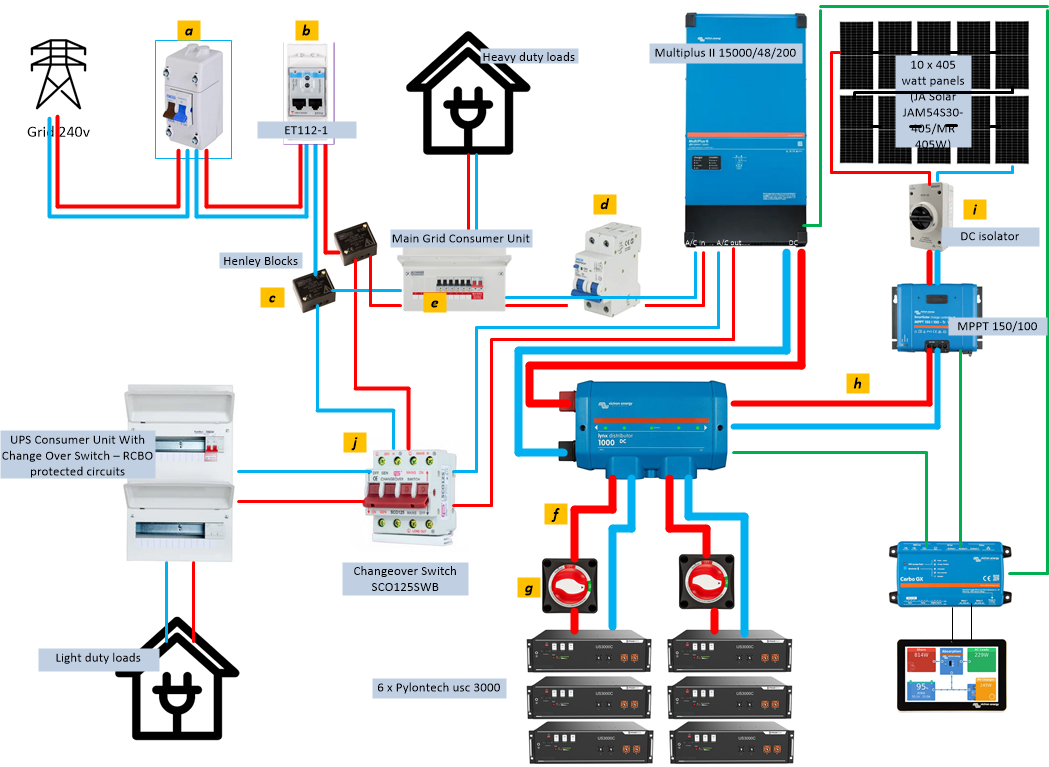Hi,
I am a keen beginner in becoming more power self-sufficient and am planning a battery/inverter/solar system.
I have included a diagram of the sort of setup I want to go for to be able to make use Victon equipment and Pylon-tech batteries to create an ESS to take advantage of cheap electricity tariffs at night here in the UK and power my house during the day through the use of a Mulitplus II inverter while also using power generated from solar for additional power and storing it using batteries. I am not at this stage wanting to feed back and export any additional power that's generated.
After reading a lot of Victron documentation and watching a fair amount about this I think I have got the general idea about how to set this up but have a few questions about the specifics of what I need which I was looking for help on.
I plan on leaving the current consumer unit in place and using it to power any heavy load items that might be needed and then using a circuit on this main consumer unit to feed into the A/C in of the Multiplus.
I am wanting to go for a Multiplus 15000/48/200 so my first question is what size/gauge of wire and fuse/mcb/rcbo do I need to feed into the Multiplus from my current CU?
The Multiplus 15000/48/200 can handle a peak of 27 000 watt using a power factor of 0.8 for average household appliances, but I believe this is only for a short amount of time (0.5 Seconds), it also seems to be able to maintain 150% for 5 seconds (18000 watts) and 130% for 30 mins (15600 watts). After looking at my usage over the last 12 months this should be plenty for my whole house at any time even when cooking on the hob and oven, using the washing machine and dishwasher along with the microwave and kettle. Any heavy-duty loads could be added directly to the main consumer unit and used mainly at night when there is cheap electricity (EV charger) but after monitoring the house usage over the last year this should be within those numbers.
The maximum feed in power is 15000va so the unit can draw approximately 12,000 watts , at 240 volt this would equate to 50 amps, what size mcb do I need to feed in, should it be an rcbo or can an rcd protected mcb be used instead, should I use a 50 amp or 63 amp breaker?
What cable should I use here, the distance is around 5-10meters, can I get away with using 10mm2? my other option is to run 25mm2 tails as I am already planning on running 1 set from the henley blocks to the UPS consumer unit directly so I can make use of a changeover switch in the UPS CU to allow for maintenance or to be able to isolate the Multiplus out of the equation. Would 25mm2 tails be overkill which is just going to cause unnecessary problems when routing in the main CU?
For the A/C out from the Multiplus to the UPS CU should I use 25 mm2 tails or is this overkill too?
Would it be wise to add further isolation other than that provided by the change over switch and the master switch in the CU?
If so should I just use the same as (a) before getting to the change over switch (j)
Do I need a current sensor, ET112-1 (b) for the Multiplus to know whats going on in this setup?
If I don't already have an isolation switch (a) before the current sensor (b) would it make sense to add one? Would it also make sense to add one after the Henley blocks for each CU to be able to isolate them independently or is this overkill and unnecessary expense?
Can I set up all 6 batteries in one bank or should they be in two banks, and depending on which , what gauge of cable do I need (f) and what isolating switches do I need (g) ?
With Victron equipment and Pylontech batteries, before connecting, do I also need to precharge the capacitors in the Multiplus with a resistor to initially charge them before connecting to the batteries?
I was looking at some 405w solar panels and have room for about 10 and was planning a series setup with a Victron MPPT, what voltage/amp of isolator (i) do I need? And what gauge of cables (h) do I need? between solar panels and MPPT (i) ? and MPPT and Lynx ditributor/Multiplus (h)? Do I need an isolator in both location?
I understand there are a lot of questions here so any help and/or links to resources is much appreciated.
 solar system layout.png
solar system layout.png
